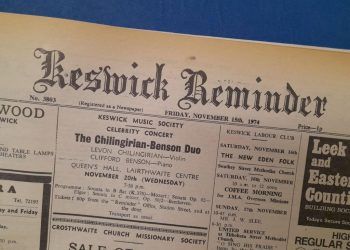
Nobbut Laiking, by Ross Brewster
All the other kids in my class drew pretty pictures of fields and trees for the competition. I spent 16 hours one weekend drawing a football ground in tribute to Archibald Leitch, the man who designed the first football stands.
My drawing had adverts for local businesses — Mandales For The Best Chips, that sort of thing. I filled my ground with 90,000 individually counted dots, each one representing a spectator.
The school’s medical officer did not exactly question my seven-year-old mental health. He described my drawing as “different”. It didn’t win a prize.
These days they would say I had a “condition” whether it be ADHD, autism or any number of other mental issues. There are serious mental health issues affecting the young, I acknowledge that. But having a condition has, with the contrivance of social media, become fashionable.
One in five children and young people had a probable mental health disorder in 2023 according to a Mental Health of Children and Young People in England panel report. The numbers are higher still in the 16-19 year olds.
The NHS has rolled out 398 mental health support teams within schools and colleges with another 200 due to become operational next year.
It’s not easy being a child. I was one myself once a very long time ago. Today’s youngsters have the additional problems of social media with its false messages and bullying and worry about the future of the planet.
Things like body image and self esteem are exacerbated. We would get rid of our tensions by going out after school and kicking a ball about. Now they disappear to their bedrooms to monitor their phones.
It wasn’t all good. I hated school. I didn’t have a lot of close friends. And I drew football grounds, which must have said something dark about my mental condition.
But should we be encouraging four-year-olds to express their mental anguish? Is “ok to not be ok” the classroom message?
It’s extra pressure on the NHS, but what worries me is the pigeonholing of kids into conditions. Maybe some of them just need to express their inner angst by drawing football pitches.
Thanks for the personal touch
My mum would start badgering me a few days after my birthday.
Write that letter thanking Aunty Edith for yet another new Bible. That made half a dozen. Aunty Edith was, as you may have guessed, a very religious lady. She alternated her Biblical gifts between Christmas and birthdays. But always a Bible.
Words, especially handwritten words, mean a lot. I am always chuffed when I get readers’ letters. I can guess from the shaky writing that many of my correspondents are elderly. I’m in that category myself and the standard of my handwriting, never good, has deteriorated as arthritis in my fingers has accelerated.
I can understand how touched King Charles must have been to receive letters wishing him well after his recent cancer announcement. They say life is an emotional journey and these messages stirred his emotions.
My mother was a stickler when it came to those thank you letters. For me it was a chore.
Yet now, as someone who is so appreciative of handwritten letters in this computer age, I see what she was getting at. The importance of a few words. The joy of the recipient. It’s so easy now to avoid writing when we can text. Why make a phone call or go out and choose a card that’s special for an occasion when we can email?
When Aunt Edith died they went through her desk. They found a little bundle of thank you letters she had saved. Each mentioning the gift of a Bible. Those Bibles never changed my views on religion, but the letters I sent must have been treasured.
Stan the man
Stan Bowles was an undoubted footballing genius. But with some of life’s counter attractions proving more attractive he never quite achieved the heights I always felt he was capable of.
Carlisle United fans paid tribute to Bowles at the last home game. Warm applause. But I wondered as the players gathered in the centre circle just how many of the people inside Brunton Park had the pleasure of seeing him play.
As one gets older the passing years tend to become landmarks. I’m on my 65th season. I was asked recently, by a football writer of note, who was the best player I had seen in Carlisle’s colours. I could easily have said McIlmoyle, my boyhood hero and scorer of 42 goals in one season, or the immaculate Chris Balderstone. They are the enduring best.
But, in an all-too-brief stay, no-one could touch Stan Bowles for sheer impudent brilliance. Carlisle got Bowles because bigger clubs were deterred by his reputation as a free spirit. How did he keep his nose clean here? “There was nothing to do,” Stan succinctly told an interviewer in his later years as Alzheimer’s began taking its cruel grip.
It was at Queen’s Park Rangers that Bowles earned legendary status. The 30-something games he played for Carlisle were a delightful cameo. One I don’t expect to see equalled.








